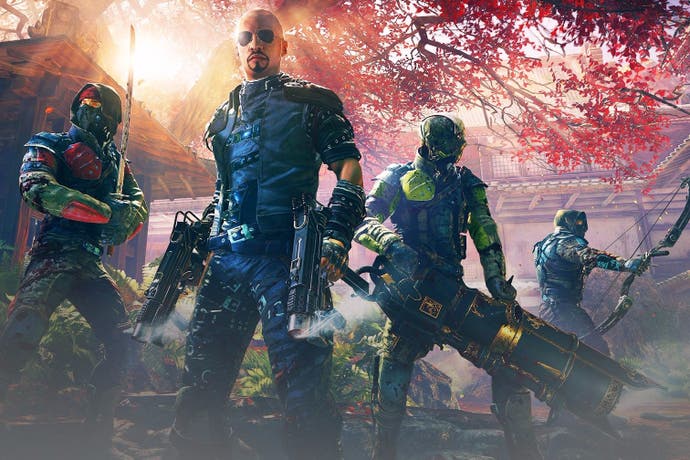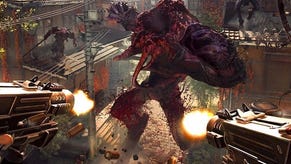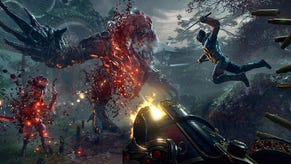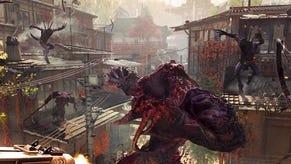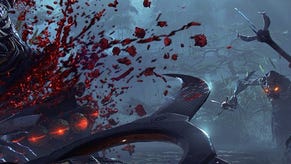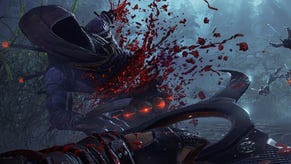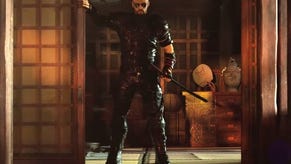Shadow Warrior 2 review
Gore-derlands.
There are two important things you need to know about the sequel to Shadow Warrior.
- It has a gun made of skulls, for which the magazine is also a skull.
- In Lo Wang's world, a gun made of skulls does not warrant any special attention whatsoever.
Indeed, if I was to rank the skullgun in a list of Shadow Warrior's best weapons, it would probably land somewhere in the mid teens, above the half-dozen or so pistols I collected, but far below the two types of chainsaw I wielded. I didn't even know you could have more than one type of chainsaw. I thought the recipe for chain plus saw had been fairly well established at this point, which goes to show you should never underestimate the creative potential of video games.
The reason I can't tell you precisely where I'd place the skullgun is because I lost count of the weapons I acquired about a third of the way through the game. But what I can tell you about Shadow Warrior's weapon roster is the guns I never touched at all could easily stock the arsenal of an entirely separate shooter.
The astonishing array of armaments in Shadow Warrior 2 is one of a litany of changes for the sequel to Flying Wild Hog's surprisingly good reboot. The result is a shooter that's a little bit Destiny and a little bit Borderlands, all slathered in the gleeful violence and self-deprecatingly scatological humour transposed from the developer's first stab at Shadow Warrior.
Mechanically it's messier than both those games, perched precariously as it is on a suitcase filled to bursting with different systems. But I also believe that ultimately it's more entertaining. Like a gun made of skulls, Shadow Warrior 2 doesn't work as well as it could, but it's rather fun watching it try.
Of all the changes made in Lo Wang's latest outing, the most significant is how it eschews the traditional FPS structure of its predecessor entirely. Instead, we're presented with a semi-open world arrangement where both story and side missions take place in procedurally generated level layouts. Missions are acquired in a small hub-like area named Dragon Mountain, where Lo Wang can also buy weapons and upgrades, and hang out in his "Wang Cave." These missions are then accessed via a map, at which point Wang automatically teleports to that location.
The location of the mission on the map roughly determines what the level will look like and the kinds of enemies that Wang will face. In the Northeast for example, is Zilla City, a towering, neon-soaked metropolis patrolled by cyborg ninjas and ED-209 like mechs (clearly the developers have been to Newcastle). Meanwhile, the centre of the map is dominated by cramped Japanese townscapes with meandering roads and twisting alleyways, and fractured countryside undercut by cave systems and sprinkled with Buddhist temples.
While each environment-type is visually striking and attractive, the fact they're procedurally generated makes little impact upon the act of play. The algorithm never puts out anything particularly memorable. Each level is a jumbled lump of theme, and apart from, say, the time of day or the weather conditions, there's nothing to make a specific mission stand out in the way that a planet in No Man's Sky might. Also, most of the time you're too busy painting the landscape in gushing scarlet to pay much attention to the finer details.
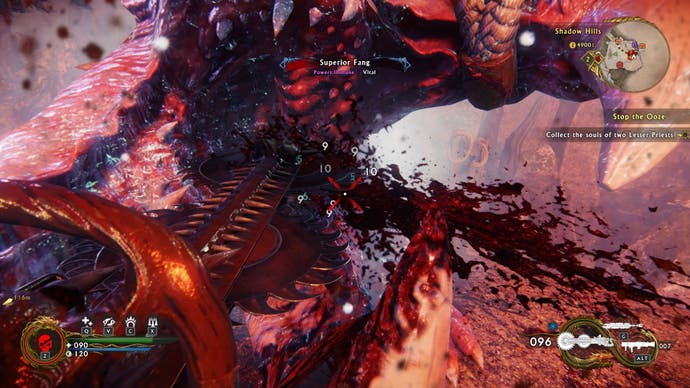
Shadow Warrior 2 certainly doesn't shortchange you on the action, boasting amongst its features a dynamic dismemberment system that evokes conflicting memories of Soldier of Fortune's GHOUL technology. As for the shooting itself, I must admit at first I was concerned that the developers had cocked it up. The introductory weapons are depressingly underpowered. The revolver and the shotgun lack punch, while the machine-pistol puffs with all the force of an e-cigarette. Only Wang's katana retains its lethality, its charged stab and "vortex" power attacks carrying a satisfying heft.
After 30 minutes or so, however, Shadow Warrior 2 reveals its strongest asset - diversity. The weapon roster is truly huge, including a small army's worth of FPS staples like pistols, revolvers, shotguns, auto-shotguns, machineguns, grenade launchers and rocket launchers. But it's the more bizarre inclusions that are often the most fun. The nailguns are excellent and the gauss cannons extraordinary. Melee weapons such as plasma spitting shortswords and Wolverine-like claws are devilishly enjoyable too, although with larger enemies it can feel like you're flailing your weapons in front of them, rather than actually striking them. Not every weapon is unique, with many move-sets and reload animations repeated. Yet unlike the incremental randomness of Borderlands, each is distinct enough to warrant investigation. What's more, all weapons can be customised through a range of generated upgrades. It's entirely possible to create a rocket launcher that fires toxic shells, or a bow that shoots scattering arrows that explode upon impact.
Enemies, too, come in many shapes and sizes. The demons are particularly colourful. Serpentaurs, for example, can divide into multiple enemies, while the doglike "Fang" creatures can lasso you with their tongues and yank you into their gaping maws. There are even small, skittering demons which, when attacked, visibly mutate into a much larger and more dangerous beast, with an animation that is equal parts impressive and disgusting. Each type of enemy comes in various sizes too, with "Superior" and "Elite" versions both dealing and absorbing more damage.
Whatever the opponent, they all like to attack in numbers, and consequently survival depends heavily on using Wang's "dash" ability to weave amongst your opponents, dealing as much damage as you can before pulling back, healing up and diving back in again. Some enemies are resistant or vulnerable to certain types of damage, which adds a little tactical play to the proceedings. In moment-to-moment play, it doesn't quite equal Doom's graceful ballet of violence, but it also has more rhythmic breadth to its action (and far better chainsaws, I'd like to add).
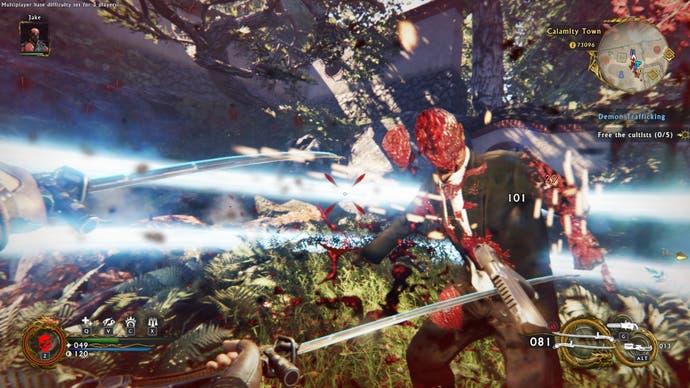
Indeed, Shadow Warrior revels in its motley colours. Consistency is secondary to variety, and this can make it a rather uneven experience. Some enemies, such as floating drones and heel-nipping Ratverines, aren't much fun to fight, while a fair number of the weapons, particularly pistols and shotguns, feel underpowered when fired. The humour is similarly scattershot, with a barrage of crude jokes and relentless Wang puns intermingling with genuinely funny witticisms. When Wang remarks upon a demonic shopkeeper's efforts at keeping his nose clean in the business of selling weapons, the shopkeeper responds "This ain't my nose." Generally, Shadow Warrior is funniest when the humour off-the-cuff, and trying least to offend.
Many of Shadow Warrior 2's changes are plainly in aid of cooperative play. Unfortunately, there's one big problem with this. Shadow Warrior 2 is actually less fun in coop. The game is most enjoyable when you're fighting lots of fairly weak enemies, where Wang's eclectic arsenal is at its deadliest. But the game responds to an extra player by making enemies tougher, transforming an individual power trip into a cooperative grind. It's still fun enough, but it's a rare inversion of the usual trajectory of games that add a cooperative mode.
The new structure also impacts upon the game's plot and characterisation. This may seem like a silly complaint, given Shadow Warrior's primary storytelling concern is the many ways in which you can chop up a demon. But the previous game had a surprisingly compelling dynamic between Wang and his demonic companion Hoji, a genuinely great character who was the source of much of that game's humour and drama. Shadow Warrior 2's companion, the granddaughter of a Yakuza boss whose consciousness ends up temporarily housed in Wang's own head (if it's not absurd, it's not Shadow Warrior) has none of Hoji's fun or depth. Her personality is essentially "Spoiled Beverly Hills teenager," which is a poor foil to Wang's juggernaut-like machismo.
I like Shadow Warrior 2, and I think the direction the developers have taken is ultimately the correct one. But I'm not as enamoured with it as I was the previous game. There I played because I was actually interested in what was happening. Here I'm playing in an endless search for a sharper sword, or a better boomstick, always pushing that big red button in Flying Wild Hog's randomly generated Skinner Box. That's absolutely fine, and in terms of madcap FPS action it's definitely worth playing. But unlike the first game, I doubt I'll remember much about it in a few years' time.
